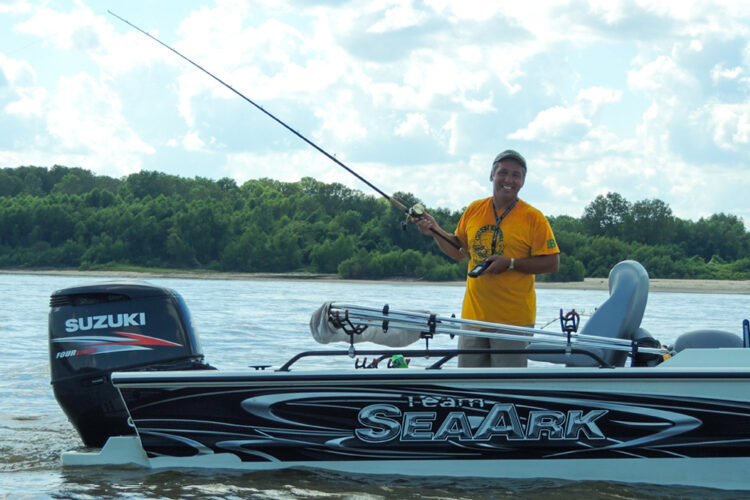Finding a catfish highway and controlling the boat with a trolling motor is a common method for catching Mississippi River cats. Jon Warden is shown here bumping near Memphis.
Pig Paths
Looking for the mailbox on ol’ sad daddy road.
by Ron Presley
There is an old saying that if you want to catch fish you have to fish where the fish are. If you can find the boulevard that the catfish use to travel from spot to spot you can rest assured that they will be strolling down that (familiar) beaten path at one time or another.
It’s no secret that catfish move from place to place and understanding that movement will make anyone a better catman or catwomen. Some of these highways are natural occurrences, others are man-made.
Old creek channels, rocky ledges, small stock ponds, and downed timber become a part of the underwater highway system once submerged in lakes and reservoirs. That old creek that once had the family fishing along the bank for panfish may now be 20 feet under water. Likewise, that rocky ledge along the river shore that went straight down into deep water is now unseen to the naked eye. It is in fact, providing a perfect ambush point for all kinds of hungry fish.
Man-made structures are things like the old road that led from the main farmhouse to the barn. It will retain its ruts and side ditches for many years after being submerged. Whether they were dirt, gravel, or paved, submerged roads are one more component of the system of highways that catfish use to travel in search of their next meal.

When Jeff Dodd thinks of catfish highways, he has a very specific structure in mind, but they can be found in different areas. Larry Muse likes to find and fish the current seams associated with those highways.
“Channel ledges are excellent targets for big cats,” Dodd said. “You can find them in a lot of different places. It may be a creek ledge or may be just a two-foot deeper ditch that’s running across a feeding flat. My favorite catfish highway is a steep river ledge. I call it a guardrail; it is something for fish to follow along.”
Once Dodd finds his guardrail, the next decision is how to fish it. The two most often used methods are bumping and dragging.
“If I have current, I like to bump along the guardrail,” advised Dodd. “Usually there will be a little deeper ditch at the bottom of the ledge. I try to hold my bait right in that little depression. I keep an eye on the graph and make adjustments with the trolling motor to follow the contour of the ledge.”
Dodd is a big bait fisherman. He doesn’t hide the fact that he is after big fish and he uses big baits to get em’. He has proven the strategy to be successful many times.
“In a lake without current I am more likely to be dragging bait,” continued Dodd. “My target is the same. I want to drag a bait right next to that ledge. I use the same big baits that I would bumping, but I am dragging four B’n’M rods.”

Dodd ended the tutorial by pointing out how a creek channel is a real good highway that varies with conditions. If the water is rising, the fish will be moving shallow. If the water is falling the fish will be moving deeper.
Muse reminds anglers that if current is present those catfish highways can produce current seams. Basically, a current seam is the change in speed of the river current where the main flow of water is blocked by some object or structure in the river. The result is a faster current next to a slower current.
A line of commercial barges tied up along the shore will create a current seam. The contour of the bottom will also create seams that may or may not be readily visible on the surface.
Catfish anglers search for current seams to fish because that slower water gives the fish a place to get out of the stronger current and feed. Also, the seams are collecting drifting food where the two speeds come together. Fish then come in to feed on Mother Nature’s buffet.
It there is no current, like in a reservoir, there might not be any visible seams, but those bottom contours can still be found with sonar. Muse looks for strips of calmer water to identify the seams that are being created by the structure.
“Drifting the seams will put your bait in the same place that it put the fish,” explains Muse. “Just don’t try to fight it. With experience you will learn that those paths are changing a little bit from one drift to the next.”
“The key is watching your line,” continued Muse. “Bump down through there and control the boat to follow where the river is taking your bait. In other words, keep the line straight behind the boat.”
Remember, some kind of structure broke up the water flow and began the current seam. But the flow is not a fixed path. The water moves a little from side to side as it flows downriver.
“When you make a second and third drift don’t fight it to try and follow the exact route again,” advised Muse. “Just starting at the same place and going with the flow has worked best for me. The fish are just taking the path of least resistance.”
These two experienced catfish anglers have fished as teammates in the past, but they are normally competitors on the water. Either way, Muse and Dodd are always willing to share their accumulated knowledge with others in the spirit of growing the sport. Got a question? Just ask them.



